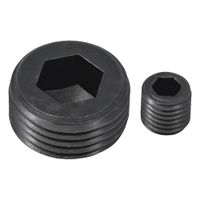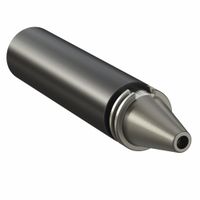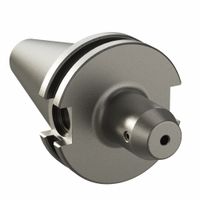Call +(254) 703 030 000 / 751 483 999 / 721 704 777
- Home
- Machining
- Toolholding Tooling Systems
- End Mill Holders Adapters Accessories
.....Read More
Frequently Asked Questions
What is the difference between an end mill holder and a collet chuck?
An end mill holder and a collet chuck are both tool holders used in machining, but they have distinct differences in design and application.
An end mill holder is specifically designed to hold end mills. It features a set screw that secures the tool by clamping onto the flat side of the end mill's shank. This provides a strong grip, ensuring the tool does not slip during heavy cutting operations. End mill holders are typically used for larger diameter tools and are known for their rigidity and stability, making them suitable for heavy-duty milling tasks. However, they offer less flexibility in terms of tool size variation, as each holder is designed for a specific shank diameter.
A collet chuck, on the other hand, uses a collet to hold the tool. The collet is a sleeve that forms a collar around the tool shank and is tightened by a nut, providing a uniform grip around the entire circumference of the tool. This design allows for a higher degree of precision and concentricity, making collet chucks ideal for applications requiring high accuracy. Collet chucks are versatile, accommodating a range of tool sizes with different collets, and are commonly used for smaller diameter tools. However, they may not provide the same level of rigidity as end mill holders for heavy cutting operations.
In summary, the main differences lie in their design, grip mechanism, and application suitability: end mill holders offer rigidity for heavy-duty tasks with specific tool sizes, while collet chucks provide precision and flexibility for a range of tool sizes.
How do I choose the right end mill holder for my milling machine?
To choose the right end mill holder for your milling machine, consider the following factors:
1. **Machine Compatibility**: Ensure the holder is compatible with your milling machine's spindle type and size, such as R8, CAT, BT, or HSK.
2. **Tool Holding Method**: Decide between collet chucks, end mill holders, or shrink fit holders. Collet chucks offer versatility for different shank sizes, end mill holders provide a secure grip for specific shank diameters, and shrink fit holders offer high precision and rigidity.
3. **Shank Size**: Match the holder to the shank size of the end mills you plan to use. Common sizes include 1/8", 1/4", 3/8", 1/2", and metric equivalents.
4. **Runout Tolerance**: Choose a holder with minimal runout to ensure precision and reduce tool wear. High-precision holders are essential for tight-tolerance applications.
5. **Material and Coating**: Select holders made from durable materials like alloy steel or carbide, and consider coatings that enhance performance and longevity, such as TiN or TiAlN.
6. **Balance and Vibration**: Opt for balanced holders to minimize vibration, especially for high-speed applications, to improve surface finish and tool life.
7. **Tool Change Frequency**: If frequent tool changes are required, consider quick-change systems to reduce downtime.
8. **Cost and Budget**: Balance the cost with the performance requirements. High-end holders offer better precision and longevity but come at a higher price.
9. **Application Requirements**: Consider the specific machining operations, such as roughing or finishing, and choose a holder that meets the rigidity and precision needs.
10. **Brand and Quality**: Choose reputable brands known for quality and reliability to ensure consistent performance.
By evaluating these factors, you can select an end mill holder that optimizes performance, precision, and efficiency for your specific milling applications.
What are the advantages of using end mill holders over collets?
End mill holders offer several advantages over collets:
1. **Rigidity**: End mill holders provide greater rigidity due to their solid construction and the use of set screws to secure the tool. This reduces tool deflection and vibration, leading to improved surface finish and dimensional accuracy.
2. **Tool Security**: The set screw in end mill holders directly contacts the flat on the tool shank, ensuring a secure grip. This minimizes the risk of tool slippage during heavy cutting operations, which is a common issue with collets under high torque.
3. **Consistent Tool Length**: End mill holders maintain a consistent tool length, as the tool is inserted until it bottoms out in the holder. This is crucial for repeatability in production environments where tool length offsets are critical.
4. **Ease of Use**: Changing tools in end mill holders is straightforward, as it involves simply loosening the set screw, replacing the tool, and retightening. This can be quicker than dealing with collet nuts and the potential need for multiple collet sizes.
5. **Durability**: End mill holders are generally more robust and less prone to wear compared to collets, which can deform over time with repeated tightening and loosening.
6. **Cost-Effectiveness**: While the initial cost of end mill holders may be higher, their durability and the reduced need for multiple collet sizes can lead to cost savings in the long run.
7. **High Torque Applications**: End mill holders are better suited for high torque applications due to their secure tool holding capability, making them ideal for heavy milling operations.
These advantages make end mill holders a preferred choice in applications requiring high precision, repeatability, and heavy-duty performance.
How do I properly install an end mill in a holder?
1. **Select the Right Holder**: Choose a holder compatible with your end mill's shank size and type (e.g., collet chuck, end mill holder, or shrink fit).
2. **Clean Components**: Ensure both the end mill and holder are clean. Remove any debris, oil, or residue to ensure a secure fit.
3. **Inspect the End Mill**: Check the end mill for any damage or wear. Replace if necessary.
4. **Insert the End Mill**:
- For a collet chuck: Insert the end mill into the collet, ensuring it is fully seated.
- For an end mill holder: Align the flat on the end mill shank with the set screw in the holder.
5. **Secure the End Mill**:
- For a collet chuck: Insert the collet with the end mill into the chuck body. Tighten the collet nut by hand, then use a wrench to secure it further. Ensure even pressure to avoid misalignment.
- For an end mill holder: Tighten the set screw against the flat of the end mill shank using a torque wrench to the manufacturer's specifications.
6. **Check Alignment**: Ensure the end mill is properly aligned and not protruding excessively, which can cause chatter or breakage.
7. **Test Run**: Perform a test run at low speed to check for any wobble or misalignment. Adjust if necessary.
8. **Final Tightening**: After confirming alignment, perform a final tightening to ensure the end mill is securely held.
9. **Safety Check**: Ensure all tools and wrenches are removed from the machine before starting the operation.
10. **Documentation**: Record the setup parameters for future reference, including tool length and holder type.
What maintenance is required for end mill holders and adapters?
End mill holders and adapters require regular maintenance to ensure optimal performance and longevity. Key maintenance tasks include:
1. **Cleaning**: Regularly clean the holders and adapters to remove chips, dust, and coolant residues. Use a soft brush or compressed air to clean the internal and external surfaces. Avoid using harsh chemicals that could damage the metal.
2. **Inspection**: Frequently inspect for wear, damage, or corrosion. Check for signs of wear on the taper, threads, and set screws. Ensure that the holder and adapter are free from cracks or deformities.
3. **Lubrication**: Apply a light coat of rust-preventive oil to prevent corrosion. Ensure that moving parts, such as set screws or locking mechanisms, are adequately lubricated to function smoothly.
4. **Alignment and Calibration**: Regularly check the alignment and calibration of the holders and adapters to ensure precision in machining operations. Misalignment can lead to poor machining quality and increased tool wear.
5. **Tightening and Torque**: Ensure that all screws and bolts are properly tightened to the manufacturer's recommended torque specifications. Loose components can lead to tool slippage and damage.
6. **Storage**: Store holders and adapters in a clean, dry environment to prevent rust and corrosion. Use protective caps or covers to shield the taper and other critical surfaces.
7. **Replacement of Worn Parts**: Replace any worn or damaged components promptly to maintain the integrity of the tool holder system. This includes set screws, collets, and other replaceable parts.
8. **Documentation**: Keep a maintenance log to track inspections, cleaning, and any replacements or repairs. This helps in scheduling regular maintenance and identifying recurring issues.
By adhering to these maintenance practices, end mill holders and adapters can maintain their precision and extend their service life, ensuring efficient and accurate machining operations.
Can end mill holders be used with all types of milling machines?
End mill holders are not universally compatible with all types of milling machines. Their compatibility depends on several factors, including the machine's spindle type, the holder's design, and the specific requirements of the milling operation.
1. **Spindle Taper Compatibility**: Milling machines have different spindle taper standards, such as R8, CAT, BT, and HSK. End mill holders must match the machine's spindle taper to ensure proper fit and function. An R8 end mill holder, for example, will not fit a machine with a CAT40 spindle without an adapter.
2. **Machine Size and Capacity**: The size and power of the milling machine also determine the suitability of an end mill holder. Larger machines with more horsepower can handle larger end mill holders and cutters, while smaller machines may require more compact holders to avoid overloading the spindle.
3. **Type of Milling Operation**: Different milling operations may require specific types of end mill holders. For instance, high-speed machining might necessitate balanced holders to reduce vibration, while heavy-duty cutting might require more robust holders to withstand higher forces.
4. **Tool Holding System**: Some milling machines use specific tool holding systems, such as collet chucks or hydraulic chucks, which may not be compatible with standard end mill holders. In such cases, adapters or entirely different tool holding solutions may be needed.
5. **Machine Age and Technology**: Older machines might not support modern end mill holders designed for high-speed or high-precision applications. Conversely, newer machines might have advanced features that require specific holder types for optimal performance.
In summary, while end mill holders are versatile, their use is contingent upon the compatibility with the milling machine's spindle type, size, and the specific requirements of the milling task. Always ensure that the holder matches the machine's specifications and the operation's demands.
What are the common sizes and types of end mill holders available?
End mill holders are essential tools in machining, used to hold end mills securely during milling operations. They come in various sizes and types to accommodate different milling machines and applications.
**Common Sizes:**
1. **Shank Diameter:** End mill holders are available in various shank diameters, typically ranging from 1/8 inch to 2 inches or more. The most common sizes are 1/4 inch, 3/8 inch, 1/2 inch, 3/4 inch, and 1 inch.
2. **Length:** The length of end mill holders can vary, with standard lengths being short, medium, and long. The choice depends on the depth of cut and the reach required for the operation.
**Common Types:**
1. **Weldon Shank Holders:** These have a set screw that secures the end mill by clamping onto a flat on the shank. They are simple and effective for general-purpose milling.
2. **Collet Holders:** These use a collet to grip the end mill, providing a more concentric and secure hold. They are suitable for high-precision applications.
3. **Hydraulic Holders:** These use hydraulic pressure to clamp the end mill, offering excellent concentricity and vibration dampening, ideal for high-speed and high-precision milling.
4. **Shrink Fit Holders:** These use thermal expansion to hold the end mill. They provide high precision and rigidity, suitable for high-speed machining.
5. **Morse Taper Holders:** These are used for larger machines and provide a self-locking taper fit, suitable for heavy-duty milling.
6. **BT, CAT, and HSK Holders:** These are standardized holders used in CNC machines, with BT and CAT being more common in the US and HSK in Europe. They offer high precision and quick tool changes.
Choosing the right end mill holder depends on the specific requirements of the milling operation, including the machine type, material, and desired precision.


